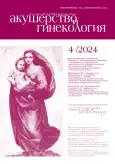Delivery in a pregnant woman with a bicornuate uterus and a scar after cesarean section
- 作者: Babich T.Y.1,2, Sulima A.N.1,3, Baskakov P.N.1, Suleymanova S.R.4
-
隶属关系:
- Order of the Red Banner of Labor Medical Institute named after S.I. Georgievsky, V.I. Vernadsky Crimean Federal University
- N.A. Semashko Republican Clinical Hospital, Perinatal Centre
- Simferopol Clinical Maternity Hospital No. 1
- City Hospital No. 9, Sevastopol
- 期: 编号 4 (2024)
- 页面: 168-172
- 栏目: Clinical Notes
- ##submission.datePublished##: 17.05.2024
- URL: https://journals.eco-vector.com/0300-9092/article/view/632165
- DOI: https://doi.org/10.18565/aig.2023.223
- ID: 632165
如何引用文章
详细
Relevance: In the prenatal period, developmental abnormalities may occur under the influence of various exogenous and endogenous factors. Patients with a bicornuate uterus account for 0.4% of the total number of women, 1.1% of women with infertility and 2.1% of women who had a miscarriage. It is difficult to calculate the real prevalence of this abnormality of uterine development; however, the management of pregnancy and childbirth with a bicornuate uterus remains a relevant issue and challenge for doctors.
Case report: A 34-year-old patient, who had a previous history of childbirth by cesarean section due to a bicornuate uterus, was admitted to the obstetric department of the hospital. Due to the patient’s strong desire, doctors chose the tactics of vaginal delivery. The first stage of labor was uneventful, and a single dose of epidural analgesia was given. The second stage of labor was complicated by fetal distress, which led to the use of vacuum extraction of the fetus. A live full-term boy was delivered weighing 3030 g, 50 cm tall, with a score of 8 and 9 on the 1- and 5-minute by Apgar, respectively. During the entire period of labor, there were regular contractions of the uterus, lasting from 30 seconds in the first stage of labor to 1.5 minute in the active pushing phase of the second stage of labor.
Conclusion: It is possible for women with uterine malformations to give birth vaginally. It is necessary to study this abnormality, generalize and systematize the data in order to develop diagnostic algorithms and therapeutic approaches for the clinicians and their routine practice.
全文:
作者简介
Tatyana Babich
Order of the Red Banner of Labor Medical Institute named after S.I. Georgievsky, V.I. Vernadsky Crimean Federal University; N.A. Semashko Republican Clinical Hospital, Perinatal Centre
编辑信件的主要联系方式.
Email: 7047715@mail.ru
ORCID iD: 0000-0003-3274-0698
Dr. Med. Sci., Associate Professor, Professor of the Department of Obstetrics, Gynecology and Perinatology No. 1
俄罗斯联邦, Simferopol; SimferopolAnna Sulima
Order of the Red Banner of Labor Medical Institute named after S.I. Georgievsky, V.I. Vernadsky Crimean Federal University; Simferopol Clinical Maternity Hospital No. 1
Email: gsulima@yandex.ru
ORCID iD: 0000-0002-2671-6985
Dr. Med. Sci., Professor, Professor of the Department of Obstetrics, Gynecology and Perinatology No. 1
俄罗斯联邦, Simferopol; SimferopolPetr Baskakov
Order of the Red Banner of Labor Medical Institute named after S.I. Georgievsky, V.I. Vernadsky Crimean Federal University
Email: petr.baskakov@gmail.com
ORCID iD: 0000-0002-7382-7434
Dr. Med. Sci., Professor, Professor of the Department of Obstetrics, Gynecology and Perinatology No. 1
俄罗斯联邦, SimferopolSabrie Suleymanova
City Hospital No. 9, Sevastopol
Email: sabrie97@mail.ru
ORCID iD: 0000-0002-9902-7726
Obsteterician-Gynecologist
俄罗斯联邦, Sevastopol参考
- Cunningham F.G. Williams obstetrics. 24th ed. New York: Mcgraw-hill; 2014. 1376 p.
- Venetis C.A., Papadopoulos S.P., Campo R., Gordts S., Tarlatzis B.C., Grimbizis G.F. Clinical implications of congenital uterine anomalies: a meta-analysis of comparative studies. Reprod. Biomed. Online. 2014; 296): 665-83. https://dx.doi.org/10.1016/j.rbmo.2014.09.006.
- Gundabattula S.R. Reproductive outcomes after resection of intrauterine septum. J. Obstet. Gynaecol. 2014; 34(3): 235-7. https://dx.doi.org/10.3109/ 01443615.2013.836477.
- Practice Committee of the American Society for Reproductive Medicine. Uterine septum: a guideline. Fertil. Steril. 2016; 106(3): 530-40. https://dx.doi.org/10.1016/j.fertnstert.2016.05.014.
- Chan Y.Y. The prevalence of congenital uterine anomalies in unselected and high-risk populations: a systematic review. Hum. Reprod. Update. 2011; 17(6): 761-71.
- Суханов А.А., Обрядов М.А., Дикке Г.Б., Кукарская И.И. Успешное родоразрешение двухплодной беременности у пациентки с редким пороком развития половых органов. Акушерство и гинекология. 2023; 11: 205-10. [Sukhanov A.A., Obryadov M.A., Dikke G.B., Kukarskaya I.I. Successful delivery of a two-fetus pregnancy in a patient with a rare malformation of the genital organs. Obstetrics and Gynecology. 2023; (11): 205-10. (in Russian)]. https://dx.doi.org/10.18565/aig.2023.246.
- Roly Z.Y., Backhouse B., Cutting A., Tan T.Y., Sinclair A.H., Ayers K.L. et al. The cell biology and molecular genetics of Müllerian duct development. Wiley Interdiscip. Rev. Dev. Biol. 2018; 7(3): e310. https://dx.doi.org/10.1002/wdev.310.
- Passos I.M.P., Britto R.L. Diagnosis and treatment of müllerian malformations. Taiwan. J. Obstet. Gynecol. 2020; 59(2): 183-8. https://dx.doi.org/10.1016/ j.tjog.2020.01.003.
- Deutch T.D., Abuhamad A.Z. The role of 3‐dimensional ultrasonography and magnetic resonance imaging in the diagnosis of Müllerian duct anomalies: a review of the literature. J. Ultrasound Med. 2008; 27(3): 413-23. https://dx.doi.org/10.7863/jum.2008.27.3.413.
- Андреева М.В., Линченко Н.А., Шевцова Е.П. Исход беременности и родов при аномалиях развития половых органов. Акушерство и гинекология. 2020; 7: 166-9. [Andreeva M.V. Linchenko N.A., Shevtsova E.P. Pregnancy and delivery outcomes in genital malformations. Obstetrics and Gynecology. 2020; (7): 166-9. (in Russian)]. https://dx.doi.org/10.18565/aig.2020.7.166-169.
- Makiyan Z. Systematization for female genital anatomic variations. Clin. Anat. 2021; 34(3): 420-30. https://dx.doi.org/10.1002/ca.23668.
补充文件










